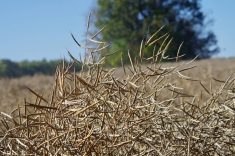Soybean and corn futures at the Chicago Board of Trade (CBOT) have moved sharply lower the past few weeks as looming harvest pressure and global financial uncertainty weigh on values.
The path of least resistance was expected to remain to the downside through the harvest season, barring a weather scare or sharp move in the outside financial markets.
“You can definitely say the seasonal highs are in for now, and the trend is to sell rallies,” said Scott Capinegro, president of Chicago-area firm Barrington Commodity Brokers.
Read Also

U.S. livestock: Cattle futures surge as second screwworm case announced
Chicago | Reuters – Chicago Mercantile Exchange cattle futures rallied on Friday as two new screwworm cases were announced in…
While the seasonal highs, set in late August, are in, Capinegro said the downside targets in both soybeans and corn still remained to be seen.
“There are still a lot of unknowns,” he said, pointing to the global economic situation and uncertainty of demand going forward.
“The early-harvested (corn) yields are coming out a lot better than what was first thought,” he said. However, “harvested acres could definitely change the picture back to the upside if we lose a million-plus (acres),” he added.
For corn, the issue of how much corn will be displaced by feed wheat in livestock rations also remains to be seen.
Looking at soybeans, China is currently not a major purchaser in the market and Capinegro said participants will be watching to see if the country comes back to make some purchases.
Another factor that could spill into both soybeans and corn is the U.S. winter wheat crop. If the southern U.S. Plains don’t get any rain over the next month and farmers there are unable to seed winter wheat, Capinegro said a rally in wheat would spill into soybeans and corn.
“They’ll need to start seeing one-inch rains every week or more; it’s just that dry down there,” he said.















